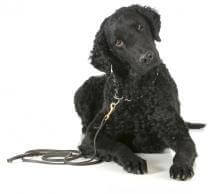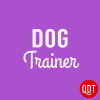Polite Leash Walking, Part 1
Set yourself up for success in teaching your dog to walk on leash without pulling. Learn why it’s so unnatural for dogs to walk this way, and how you can help your dog get it right.
Jolanta Benal, CPDT-KA, CBCC-KA
Listen
Polite Leash Walking, Part 1

Bring a human friend along on an off-leash hike with your dog, and you’ll see right away why polite leash walking is so hard to teach. As long as the path is wide enough, you and your human friend walk side by side; the social norm is that you adjust your pace to match each other. What does your dog do? She trots and sniffs and runs loops around you. Every so often she comes and checks in with you. Occasionally maybe she takes a few steps parallel to you, right at your side. In general, the doggy way of “going for a walk with a friend” is not the human way. Your gaits don’t match and your priorities differ.
But you can teach your dog polite leash walking, even though it comes so unnaturally to her. This week, 5 pointers to set you and Dogalini up for success.
- Make Sure Your Dog is Well Exercised
Even the bounciest dog walks more slowly when she’s tired. A dog who’s walking more slowly is more likely to find herself next to you, so you can reward her for being there. (And the more often she’s rewarded for being there, the more likely it is that she’ll choose to walk there.)
A well-exercised dog is also more relaxed and less prone to suddenly getting all excited about that upcoming bunch of shrubbery. Now that she’s “filled up” on running around and sniffing, the big wide world – so fascinating when she first stepped outside – faces some stiff competition in the form of your food rewards.
Finally, let’s not forget that “is well exercised” is also a euphemism for “has emptied her bladder and bowels.” It’s tough to teach anybody anything when they’re dying for a pee, and that includes your Dogalini.
- Train When Your Dog is Hungry
In the early months of his life, my dog Juniper earned almost every bite of his breakfast on his morning walk with me. I took advantage of mealtime by using his food to reward him for keeping the leash slack between us and paying attention to me as we walked. When our walk was done, he had had not only his breakfast but also another pleasant round of learning a lifelong habit of polite behavior on leash.
- Be Generous
You’re teaching your dog to do something completely unnatural and, frankly, not nearly as much fun as nosing the shrubbery and trotting in big loops around you. Pay off. You caught what I said about my puppy getting his entire breakfast on walks? When we first started training, that meant a piece of kibble at almost every step we took together. And if dry dog food doesn’t cut it for your Zippy, then improve the menu: Sprinkle the food with freeze-dried liver powder, or grated Parmesan cheese. Mix in bits of leftover pasta or roast chicken. Do whatever it takes.
Cut the treats out of your dog’s daily ration, and between that and the regular exercise you’re giving him, he’ll keep trim and fit.
- . Have a Clear Mental Picture of the Result You Want
This applies to any training, really, but it’s especially important when you’re working on something that could be a little amorphous: Where, exactly, do you want your dog to walk in relation to you? Draw an invisible ring around the space at your side and reward your dog whenever she’s in it. By being consistent in this way, you can “explain” to your dog what behavior you’re looking for.
An alternative is to reward whenever the leash makes a J shape in the air – the short end of the J is the part of the leash that’s attached to your dog’s collar, and the long end comes up to your hand. Many trainers like this because it’s clean and objective: All you have to do is keep an eye on the leash and reward whenever you see that J.
- Use Different Equipment on Walks When You Can’t Train
Dogs are good at distinguishing situations and at learning that different rules apply in different situations. You already know this if your puppy has learned to greet you with all four feet on the floor but still jumps up on your spouse, who encourages her. Use “different situations, different rules” to your advantage. Suppose you usually practice loose-leash walking with a plain flat collar – then use a front-clip harness on walks when you absolutely have to get from Point A to Point B and don’t have time or inclination to train. Use a different leash, too, while you’re at it.
Encouragement for My Fellow City Dwellers
Every bit of training advice you read, everywhere, will begin by telling you to start leash practice with a tired dog whose bladder and bowels are empty. But some of us don’t have backyards. We don’t have cars in which to drive our Dogalinis and Zippys to the dog park, where they can run themselves ragged and then practice leash walking afterward. Nope, we have to step out the door first thing in the morning with a dog who’s full of pep and also full of pee and poop.
All is not lost. I live in New York City and I have taught all of my dogs to walk politely on leash. You can too.
Don’t sweat the first few minutes of the first morning walk too much – that’s dying-for-relief time, and even the best-trained dog tends to be in a hurry to find just the right spot. More important, take Tip #3 to heart: Be generous. You and your dog are starting with a handicap here, in that she’s the very opposite of tired and relaxed. You’ve got to compensate somehow, so make every single step taken with a loose leash worth your dog’s while. When attentive, polite walking is well established, you can start thinning out the number of food rewards you give, but there is no need to rush the process of building up a habit for a lifetime. Expecting too much performance for not enough paycheck is among the commonest mistakes non-trainers make. Avoid it – and that goes for you suburbanites and country types, too.
Next week, polite leash walking step by step, starting in your living room, without a leash. Stay tuned. You can follow me on Twitter, where I’m Dogalini. I’m The Dog Trainer on Facebook, and you can also write to me at dogtrainer@quickanddirtytips.com. I welcome your comments and suggestions, and though I can’t reply individually, I may use them as the basis for future articles. Thanks for reading!
Image courtesy of Shutterstock

